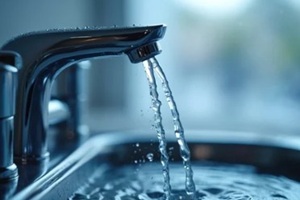
Public water systems follow strict guidelines, but unfortunately, that doesn’t always guarantee total safety. Even treated municipal water can carry contaminants that may pose risks to your health over time.
Knowing what might be in your water helps you make smarter choices about how to protect your home and family, and getting a professional well and septic inspection can help.
This article details the hidden contaminants in water that you should be aware of.
A Look at Hidden Contaminants
Municipal water systems are designed to meet federal safety standards, yet many of those standards haven’t kept pace with modern science. As a result, drinking water can legally contain contaminants at levels that still raise health concerns.
PFAS
PFAS, or per- and polyfluoroalkyl substances, are man-made chemicals found in common products like non-stick pans, stain-resistant clothing, and fire suppressants. They’re extremely persistent; they don’t break down naturally and can accumulate in both the environment and the human body.
Researchers have found that even minimal PFAS exposure can contribute to serious conditions like cancer and immune dysfunction. These substances can enter drinking water through industrial discharge or contaminated runoff that reaches rivers, lakes, and groundwater. Once in the water supply, they’re difficult to remove with standard municipal treatment methods.
Using a filtration system at home, especially one certified to remove PFAS, can significantly reduce your exposure. Awareness is growing around PFAS, and some states have moved ahead of federal guidelines with stricter limits. Still, contamination remains widespread.
Disinfection Byproducts
To prevent waterborne diseases, municipal treatment facilities use disinfectants like chlorine or chloramine. While these disinfectants control harmful microbes, they can form disinfection byproducts (DBPs) when mixed with organic material in the water.
Trihalomethanes (THMs) and haloacetic acids (HAAs) are two common disinfection byproducts known to increase cancer risk and harm fetal development. These byproducts are often found in higher concentrations in systems that treat surface water, such as lakes and rivers, rather than groundwater sources.
Simple carbon filters can reduce exposure to DBPs in drinking and cooking water. Despite federal limits on DBPs, some studies suggest that even levels considered compliant could contribute to long-term health effects, especially with prolonged exposure.
Agricultural and Industrial Runoff
Runoff from farms and industrial activity often carries contaminants into local water sources. Two common results of this are nitrate and heavy metal pollution, both of which present specific health risks.
Nitrate: A Common Threat in Groundwater

Nitrate contamination is widespread in both urban and rural water systems. It originates from fertilizer runoff, livestock waste, and wastewater discharges. Once it enters groundwater, nitrate doesn’t break down easily, making it a persistent contaminant.
Infants exposed to high nitrate levels in drinking water can develop methemoglobinemia, or “blue baby syndrome,” which limits oxygen delivery in the blood. Over time, nitrate exposure may contribute to fertility problems and increase cancer risk in adults as well.
To reduce nitrate at home, installing reverse osmosis systems is one of the most reliable methods available. If you live in an area near agricultural activity, periodic testing for nitrate levels is strongly recommended.
Heavy Metals: Arsenic and Chromium-6 in City Water
Arsenic and hexavalent chromium (chromium-6) are heavy metals that can enter drinking water through natural underground deposits or industrial pollution.
Although arsenic occurs naturally in some groundwater, it can also result from mining or the use of pesticides. Arsenic can cause cancer even at very low exposure levels, affecting the bladder, lungs, and skin.
Chromium-6, made infamous by the Erin Brockovich case, is a human-made pollutant used in manufacturing and industrial applications. It can leach into water sources from improper waste disposal. Despite its cancer risks, the federal government has not set a specific limit for chromium-6; instead, it relies on broader standards for total chromium.
Testing is the first step in identifying heavy metal contamination, and filters that use activated alumina or reverse osmosis can effectively reduce exposure in most cases.
Radiation in Water
Radiological contaminants like radium and uranium are not commonly discussed but can be found in public water supplies, especially in areas with certain types of bedrock. These elements occur naturally but may also be introduced through mining or oil and gas drilling.
The two most common forms, radium-226 and radium-228, can enter drinking water and gradually accumulate in the body. Long-term exposure increases the risk of bone cancer and other health issues, and the risks are heightened during pregnancy.
Federal guidelines for radiation in drinking water have not been updated in decades, despite newer evidence suggesting health impacts at lower levels than previously believed. Specific filtration systems are required to reduce radiological contamination, and not all standard filters are equipped to handle these elements.
VOCs and Industrial Chemicals
VOCs (volatile organic compounds) are airborne pollutants that also contaminate water supplies.
One of the most common VOCs in tap water is trichloroethylene (TCE), used in metal degreasing and dry cleaning. Improper disposal of TCE has contaminated groundwater in numerous communities across the country.
Exposure to TCE and similar compounds is associated with a higher risk of cancer, immune disorders, and birth defects. These chemicals often require advanced filtration systems to remove, including air stripping and activated carbon systems, depending on the concentration and water conditions.
VOCs don’t always produce a noticeable odor or taste, which makes regular water testing a necessary precaution in affected areas.
Clean Water Starts at Home

Knowing what can be hiding in your city’s water is an important step toward making informed decisions about your health and home. The good news is that you can effectively reduce your exposure and take control of your water quality.
At Tri-County Pump Service, Inc., we’ve been helping homeowners and businesses with water safety across Maryland, Virginia, and West Virginia since 1991. Our expert team specializes in complete water solutions, from advanced water treatment systems and filtration to well and plumbing services, including well and septic inspection in Maryland.
Contact us today for a water quality evaluation or if you have concerns about what’s in your tap. Call 1-(301)-783-0038, fill out our online contact form, or schedule a service through our website to begin.



